The Omi route is a historic place of scenic beauty. A beautiful travel experience true to this lakeside region awaits you.
Since ancient times, this area served as a hub linking the old capital to the Tokai area and to points north.
It has been the site of countless human dramas, with historical remnants everywhere. Called the “Hometown of Kannon,” it is also home to many temples and Kannon deity statues silently standing guard over the area. You will also find famous gardens and the remnants of old battle sites.

Japanese fireflies
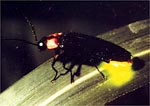 Have you ever seen fireflies at night? Their gentle, pulsing light as they fly has long stirred the heartstrings of Japanese. Unfortunately, this signature sight of summer is fast disappearing as urbanization and environmental pollution continue. The Japanese firefly, in particular, only inhabits an area ranging from Kagoshima Prefecture to Aomori Prefecture, and is a rare species unique to Japan. Every year between mid-May and early June, the fireflies appear in the area, creating a romantic symphony of light.
Have you ever seen fireflies at night? Their gentle, pulsing light as they fly has long stirred the heartstrings of Japanese. Unfortunately, this signature sight of summer is fast disappearing as urbanization and environmental pollution continue. The Japanese firefly, in particular, only inhabits an area ranging from Kagoshima Prefecture to Aomori Prefecture, and is a rare species unique to Japan. Every year between mid-May and early June, the fireflies appear in the area, creating a romantic symphony of light.Koho-an
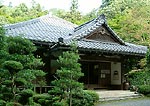 In 1653, this temple was built by Sokei, a second generation member of the Obori clan, as a family temple. The temple belongs to the Daitoku-ji chain of Rinzai sect temples and corresponds to the Daitoku-ji Koho-an found in Kyoto; this one is called Omi Koho-an. As you walk the path to the temple, you will suddenly turn to find the gates looming before you. The intriguing design is such that you do not see the entrance until it is in front of you. The garden and precinct are all done in the Enshu style, with a dry rock garden and pond that make exquisite use of the topography. The garden is beautiful year-round and is particularly breathtaking in autumn.
In 1653, this temple was built by Sokei, a second generation member of the Obori clan, as a family temple. The temple belongs to the Daitoku-ji chain of Rinzai sect temples and corresponds to the Daitoku-ji Koho-an found in Kyoto; this one is called Omi Koho-an. As you walk the path to the temple, you will suddenly turn to find the gates looming before you. The intriguing design is such that you do not see the entrance until it is in front of you. The garden and precinct are all done in the Enshu style, with a dry rock garden and pond that make exquisite use of the topography. The garden is beautiful year-round and is particularly breathtaking in autumn.
Nyoirin Kanyo Bodhisattva Odani-ji Temple (Kohoku-cho)
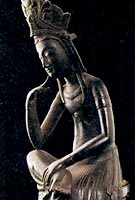 Odani-ji Temple, quietly standing at the foot of Odani Castle, was a temple which Nagamasa Azai was devoutly faithful to. In addition to the Nyoirin Kanyo statue, there is a ragaraja statue brought from Owari province when Oichi no Kata married, as well as a statue of Nagamasa himself, said to have been constructed at Osaka Castle at the order of Yododono.
Odani-ji Temple, quietly standing at the foot of Odani Castle, was a temple which Nagamasa Azai was devoutly faithful to. In addition to the Nyoirin Kanyo statue, there is a ragaraja statue brought from Owari province when Oichi no Kata married, as well as a statue of Nagamasa himself, said to have been constructed at Osaka Castle at the order of Yododono.
1,000 Hand Kannon Statue (important cultural property) Kannon-ji Temple (Kuroda, Kinomoto-cho)
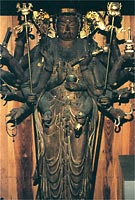 Though described as the 1,000 Hand Kannon, its form suggests that it is an image of Cundi, the mother of the myriad Buddhas and bodhisattvas. The graceful form features folds of cloth at the lower body, with a pure and austere simplicity of decoration emblematic of the esoteric Buddhist faith. This work was created by Saicho.
Though described as the 1,000 Hand Kannon, its form suggests that it is an image of Cundi, the mother of the myriad Buddhas and bodhisattvas. The graceful form features folds of cloth at the lower body, with a pure and austere simplicity of decoration emblematic of the esoteric Buddhist faith. This work was created by Saicho.
Buddha statue (important cultural property) Shaka-do (Oyama, Takatsuki)
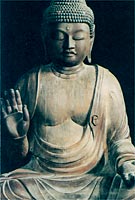 Formerly called Kokozan Anraku-ji, this famous temple is associated with Mt. Kodakami and is considered one of the seven signature temples of the area. This site grew as a training dojo for monks and prospered as a large temple. Today, the hall, installed at Hakusan Shrine, houses a mahavairocana statue.
Formerly called Kokozan Anraku-ji, this famous temple is associated with Mt. Kodakami and is considered one of the seven signature temples of the area. This site grew as a training dojo for monks and prospered as a large temple. Today, the hall, installed at Hakusan Shrine, houses a mahavairocana statue.
11-faced Kannon Deity (national treasure) Kogen-ji Temple (Takatsuki-cho)
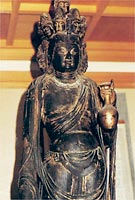 In 1653, this temple was built by Sokei, a second generation member of the Obori clan, as a family temple. The temple belongs to the Daitoku-ji chain of Rinzai sect temples and corresponds to the Daitoku-ji Koho-an found in Kyoto; this one is called Omi Koho-an. As you walk the path to the temple, you will suddenly turn to find the gates looming before you. The intriguing design is such that you do not see the entrance until it is in front of you. The garden and precinct are all done in the Enshu style, with a dry rock garden and pond that make exquisite use of the topography. The garden is beautiful year-round and is particularly breathtaking in autumn.
In 1653, this temple was built by Sokei, a second generation member of the Obori clan, as a family temple. The temple belongs to the Daitoku-ji chain of Rinzai sect temples and corresponds to the Daitoku-ji Koho-an found in Kyoto; this one is called Omi Koho-an. As you walk the path to the temple, you will suddenly turn to find the gates looming before you. The intriguing design is such that you do not see the entrance until it is in front of you. The garden and precinct are all done in the Enshu style, with a dry rock garden and pond that make exquisite use of the topography. The garden is beautiful year-round and is particularly breathtaking in autumn.
Eleven-faced Kannon Bodhisattva (important cultural property) Shakudo-ji Temple (Shakudo, Kinomoto)
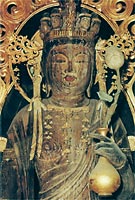 This piece, made from Japanese zelkova, is held to have been made in the middle Heian period (794-1185). The head features a rich decorative ornament, and the flowing lines around the face and hint of red on the tightly-pursed lips all suggest the kindness of the deity, giving comfort to all who gaze upon it.
This piece, made from Japanese zelkova, is held to have been made in the middle Heian period (794-1185). The head features a rich decorative ornament, and the flowing lines around the face and hint of red on the tightly-pursed lips all suggest the kindness of the deity, giving comfort to all who gaze upon it.